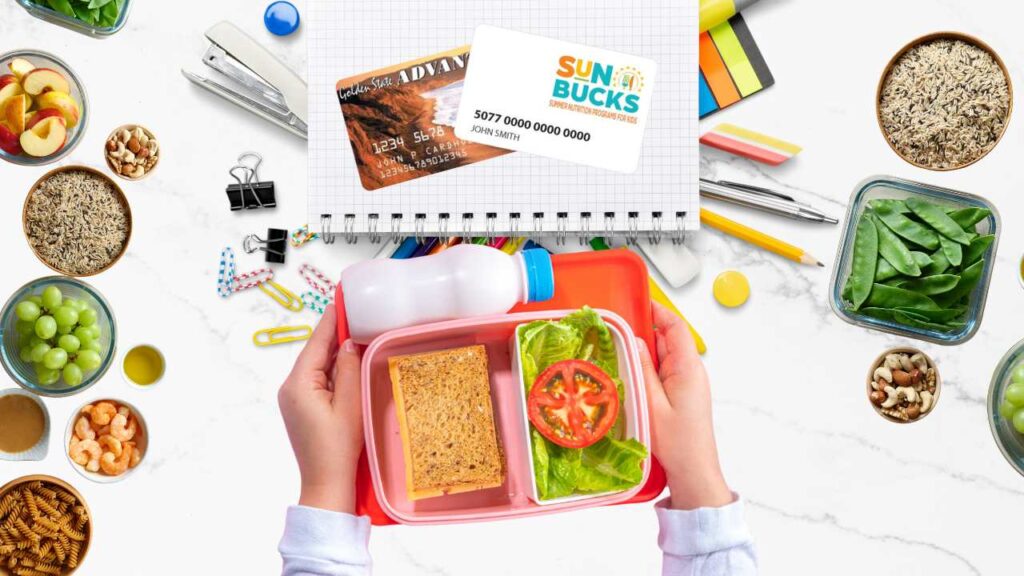The Summer EBT program, known as SUN Bucks in several states, is a federal initiative that remains active in 2025, and it’s complementary to the SNAP benefits. Its objective is to provide food assistance to low-income families during the summer months, when children lose access to subsidized school meals. This benefit is delivered through an Electronic Benefit Transfer (EBT) card with a lump sum per eligible child.
The SUN Bucks can be used at authorized supermarkets, farmers markets, and online retailers to purchase specific foods such as fruits, vegetables, meats, dairy products, and grains. Hot meals, cleaning products, and non-food items are excluded. Program operations are coordinated with states, territories, and tribal nations, resulting in variations in local implementation.
School-age children can apply for SUN Bucks food stamps
Primary beneficiaries include families with school-aged children who meet established income guidelines. Eligibility is often derived from participation in programs such as SNAP, TANF, FDPIR, or Medicaid, or from qualification for free or reduced-price meals at schools participating in the National School Lunch Program (NSLP).
Many beneficiaries are automatically enrolled, although others must complete applications. No specific immigration status is required, and the program is available in most U.S. states and territories, although not in all jurisdictions.
Nationally, the standard amount for 2025 is $120 per child in continental states, equivalent to $40 per month during June, July, and August. Alaska has regional variations between $156 and $243, while Hawaii sets the amount at $177. The program’s activation has been confirmed in multiple states, including Arizona, California, Kentucky, Michigan, and New York. Benefit distribution uses existing systems or specific EBT cards, with application deadlines varying by jurisdiction.
Let’s look at some states with active Summer EBT programs
Arizona operates under the SUN Bucks brand, with automatic benefits for children who participated in the NSLP during the 2023-2024 school year and belong to households receiving SNAP, TANF, Medicaid (up to 185% of the poverty level), foster care, or migrant programs. Those who do not meet these criteria can apply until August 5, 2025. The amount is $120 per child, issued on an EBT card that groups multiple beneficiaries from the same household.
Hawaii administers the program through its Department of Human Services. Automatic eligibility applies to children in households receiving SNAP/TANF, foster care, homeless, migrant, or approved for subsidized school meals. Students in schools with CEP programs must apply by August 3, 2025. The benefit amounts to $177 per child, with more than 80,000 beneficiaries reported through July 2025.
California calls its program SUN Bucks, with automatic enrollment for CalFresh, CalWORKs, Medi-Cal, and children in foster care or experiencing homelessness. The one-time payment of $120 is loaded onto new or existing EBT cards. Michigan reactivated the program for 2025, allowing applications through August 31 by loading existing Bridge cards or issuing new ones. The $120 must be used within 122 days of issuance.
New York began deposits on June 18, 2025, with automatic benefits for households receiving SNAP, TANF, Medicaid, or NSLP. Other applicants can apply online until August 15 if they did not receive notification. Nevada requires manual applications by August 10 for those not automatically eligible, with benefits of $120 per child. Ohio maintains automatic enrollment for SNAP, Medicaid, or OWF recipients, with the application deadline being August 15.
Pennsylvania has scheduled issuance for August 2025, allowing online or paper applications. Virginia manages one-time payments through its Virginia SUN Bucks platform. In Minnesota, those not automatically eligible can apply until August 31, receiving email notification within two weeks.
These are not all the states. According to the USDA, the states and territories and tribal nations where SUN Bucks are available are: Alabama, American Samoa, Arizona, Arkansas, California, Cherokee Nation, Chickasaw Nation, Commonwealth of the Northern Mariana Islands (CNMI), Colorado, Connecticut, Delaware, District of Columbia, Guam, Hawaii, Illinois, Kansas, Kentucky, Louisiana, Maine, Maryland, Massachusetts, Michigan, Minnesota, Missouri, Montana, Nebraska, Nevada, New York, North Carolina, North Dakota, Ohio, Oregon, Pennsylvania, Puerto Rico, Rhode Island, Utah, Vermont, Virginia, West Virginia, and Wisconsin.
